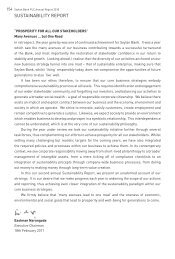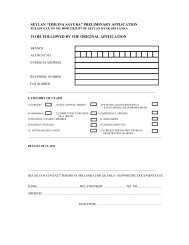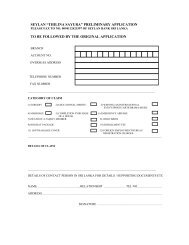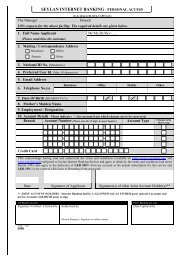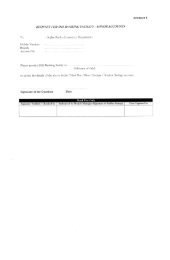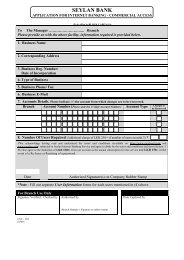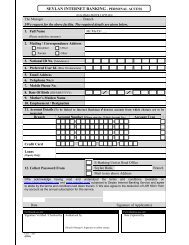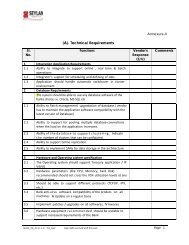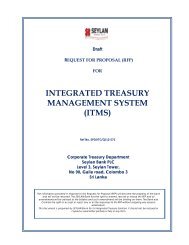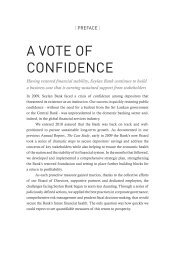The Case Study - Seylan Bank
The Case Study - Seylan Bank
The Case Study - Seylan Bank
Create successful ePaper yourself
Turn your PDF publications into a flip-book with our unique Google optimized e-Paper software.
<strong>Seylan</strong> <strong>Bank</strong> PLC Annual Report 2009 73BASEL II Implementation Plan<strong>Seylan</strong> <strong>Bank</strong> was able to face its first stage ofmeeting the challenge of implementing the BASEL IIfor credit risk - standardised approach, operationrisk - basic indicator approach, and market risk -standardised approach very successfully throughthe appointment of a dedicated committee whichcomprised several subcommittees for evaluation andimplementation involving key officers representingthe core banking areas of finance, credit, operations,branch banking, and treasury who worked tirelesslytowards achieving the set goals.<strong>The</strong> first stage, comprised three phases; that ofassessing and planning where a GAP analysis wasconducted on our processes, methods, and systemsinvolving the core system of Kapiti, and other systemsused by Treasury Operations, Pawning, Leasing,Credit Cards, etc, comparing the availability of dataagainst the required data and thereafter developinga master plan involving short-term and long-termgoals. <strong>The</strong> short-term goal was to initially achievethe CBSL stipulations of meeting the preliminarystandards by 1st January 2008, a goal which wasachieved successfully and on time.After a careful evaluation process a reputedIT software developer was hired to design thesystem to integrate the main operational systemsof the <strong>Bank</strong> in forming a common data platform andthereafter performing the following tasks ;Risk Measurement• Credit Portfolio Exposure Calculation• Upload of data• Data Validation• Calculation of gross exposure for on-BalanceSheet and off-Balance sheet items• Calculation of credit risk exposure for regulatorypurpose and• Capital charge calculations.Risk Mitigation• Setting up netting agreements and management• Calculation of impact of netting on the exposures• Collateral Management• Collateral set up• Calculation of impact of collateralisation onexposures using simple approach• Guarantees Management and• Calculation of impact of guarantees on exposures.Risk Reporting• Capital charge computation• Statutory reporting.Parallel to the above, the second stage ofgearing and preparing for the advanced approachin credit risk was launched by the introductionof internal credit scoring and rating modulesfor different types of facilities was rolled outthroughout the branch network, and credit SBUsof the <strong>Bank</strong>. <strong>The</strong>se rating modules are currentlybeing fine tuned through stress testing, and backtestingwith the view of ensuring that they reflect arealistic risk assessment of the counterparty andtransaction, prior to linking them for credit decisionmaking, risk-based pricing and the calculation ofProbability of Default, Exposure at Default, andLoss Given Default.Key Elements of Successful Basel IIRisk Management System• Sponsorship from top management.• Project implementation team who can collaboratebetween systems experts and risk experts.• <strong>Bank</strong>-wide cross-functional Taskforce, establishedto identify and prioritise data quality issues,evaluate solutions and initiate process changes.Implementing tools that detect data errors andomissions.• Discipline needed to maintain “clean” data.Reports generated regularly to ensure thaterrors are not creeping back into database.



